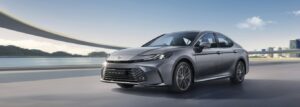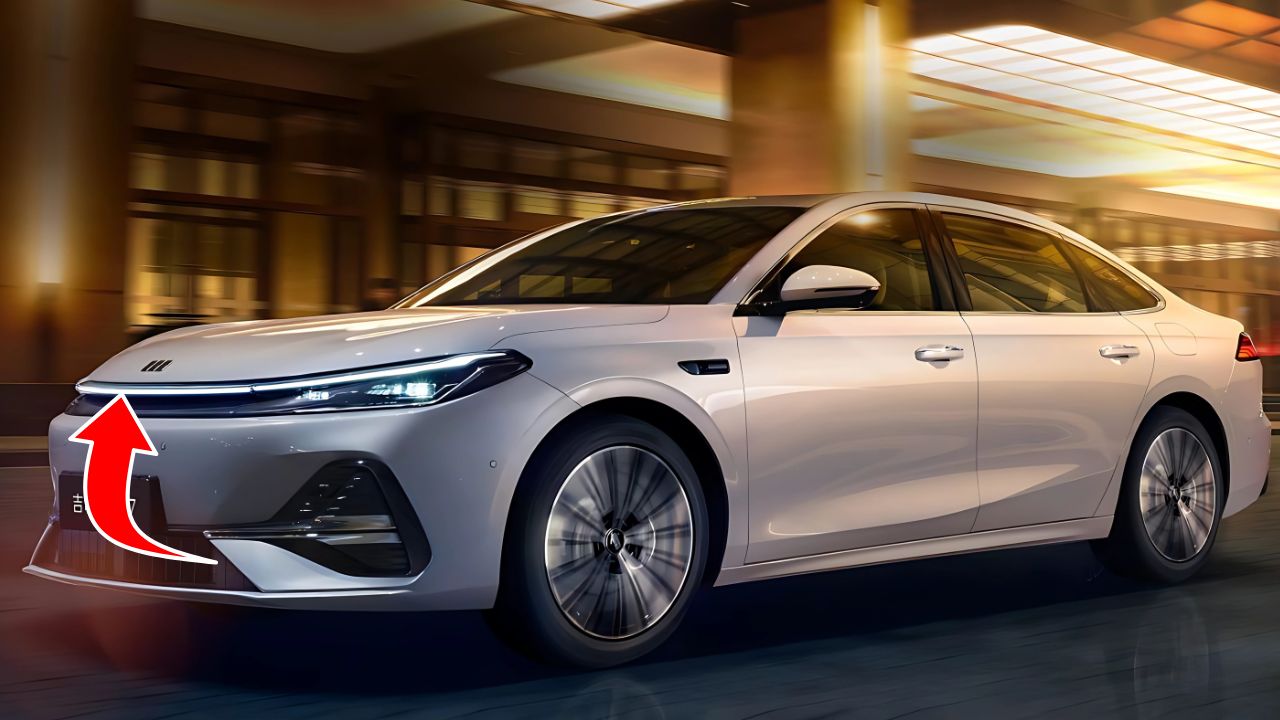The Australian automotive market is abuzz with the arrival of the 2025 Geely Galaxy A7, a plug-in hybrid sedan poised to challenge the dominance of the Toyota Camry Hybrid, a long-time favorite among Aussie families, fleet buyers, and ride-share drivers. Unveiled on June 3, 2025, via Geely’s global channels and Chinese social media platform Weibo, the Galaxy A7 boasts an astonishing 2,100km combined range, a fuel consumption of just 2L/100km when running on low battery, and a powerful hybrid system that outmuscles the Camry’s 170kW output. Priced competitively from an estimated $45,000 AUD (based on its Chinese starting price of RMB 181,800, equivalent to $36,000 AUD), the A7 combines cutting-edge technology, a sleek design, and advanced driver-assistance systems (ADAS) to appeal to eco-conscious urbanites and tech-savvy drivers. This article explores the A7’s performance, efficiency, and features, comparing it to the 2025 Toyota Camry Hybrid to determine if Geely’s new star can eclipse the Camry’s legacy in Australia.
The Geely Galaxy A7: A New Benchmark for Sedans
Geely, a global automotive giant that owns Volvo, Polestar, and Lotus, is making a bold return to Australia with the Galaxy A7, following the success of its EX5 electric SUV. The A7, part of Geely’s premium Galaxy lineup, is a mid-size sedan measuring approximately 4,950mm long with a 2,845mm wheelbase—20mm longer than the Camry’s 2,825mm—offering a spacious cabin and sleek proportions. Its exterior features a full-width LED light bar, sporty air intakes, an active grille shutter for aerodynamics, and multi-spoke alloy wheels, aligning with Geely’s modern design language seen in the Galaxy Starshine 8 and E8. The A7’s 0.27 drag coefficient enhances efficiency, rivaling the Camry’s 0.28.
Available in front-wheel-drive (FWD) and all-wheel-drive (AWD) configurations, the A7 is powered by Geely’s Thor Super Hybrid (EM) system, combining a 1.5-litre turbocharged four-cylinder petrol engine (120kW) with two electric motors (front: 100kW/320Nm; rear: 50kW for AWD models) and an 18.7kWh lithium iron phosphate (LFP) battery. The system delivers a combined 270kW and 535Nm (AWD), outpacing the Camry Hybrid’s 170kW/221Nm (FWD) or 173kW (AWD). The A7’s electric-only range is up to 80–200km (CLTC), likely 60–150km under stricter WLTP testing, compared to the Camry’s non-plug-in hybrid’s limited EV mode. Geely claims a 0–100km/h sprint in 6.5 seconds for the AWD model, edging out the Camry’s 7.2 seconds.
Efficiency: A 2,100km Range Revolution
The A7’s standout feature is its claimed 2,100km combined range with a full battery and 60-litre fuel tank, achieved under China’s lenient CLTC cycle. Real-world WLTP estimates suggest a 1,500–1,800km range, still dwarfing the Camry’s 1,250–1,400km at 3.5–4.0L/100km. When the battery is low, the A7 achieves 2L/100km, a remarkable feat for a mid-size sedan, compared to the Camry’s real-world 3.5L/100km (Chasing Cars testing). The Thor Super Hybrid system uses a three-speed Dedicated Hybrid Transmission (DHT), optimizing power delivery and efficiency across city and highway driving. The A7 supports 50kW DC fast-charging (30–80% in 25 minutes) and 6.6kW AC charging, with vehicle-to-load (V2L) capability up to 3.6kW for powering appliances, a feature absent in the Camry.

The A7’s efficiency is bolstered by regenerative braking, an active grille shutter, and low-rolling-resistance tyres. In urban settings, its 60–150km electric range covers most daily commutes, reducing fuel costs (95RON at $1.80/L in mid-2025) to near zero with regular charging. For comparison, the Camry’s non-plug-in hybrid relies on its petrol engine for longer trips, costing $31.50 to fill its 50-litre tank for 1,400km at 3.5L/100km. The A7’s larger battery and plug-in capability make it ideal for buyers with access to home or public charging, though its efficiency drops to 5.0–6.0L/100km without charging, closer to a traditional petrol sedan.
Technology and Features: A Tech-Laden Cabin
The Galaxy A7’s interior is a tech showcase, featuring a 15.6-inch touchscreen powered by Flyme Auto, a 10.2-inch digital instrument cluster, and a 10-inch head-up display (HUD). The Inspire trim adds a 16-speaker Flyme Audio system, heated/ventilated leather seats, and a panoramic sunroof. Standard ADAS includes Level 2+ autonomy with LiDAR-assisted lane-keep assist, adaptive cruise control, and autonomous emergency braking (AEB), earning a five-star ANCAP rating (pending 2025 testing). The A7’s 500L boot, expandable to 1,400L, nearly matches the Camry’s 524L, while its longer wheelbase offers more rear legroom.
In contrast, the Camry Hybrid (Ascent: $39,990; SL: $53,990) features an 8-inch or 12.3-inch touchscreen, wireless Apple CarPlay/Android Auto, and Toyota Safety Sense 3.0. Its JBL audio (SL trim) and digital rear-view mirror are premium but lack the A7’s LiDAR or expansive infotainment screen. The A7’s Flyme Auto system, while advanced, omits Android ADB mode in export markets, limiting third-party app support compared to Chinese models. Geely’s seven-year unlimited-kilometre warranty and eight-year battery warranty match or exceed the Camry’s five-year vehicle and seven-year driveline warranties, adding peace of mind for Aussie buyers.
Pricing and Value: A Camry Challenger
Estimated at $45,000–$55,000 AUD (based on RMB 181,800–220,000 in China), the A7 undercuts the Camry Ascent ($39,990) and SL ($53,990) in top trims, offering more power and a plug-in hybrid system at a competitive price. The A7’s lower running costs—potentially $0 for daily commutes with charging—appeal to urban buyers, while its V2L feature suits campers and small businesses. The Camry’s capped-price servicing ($255/visit, 12 months/15,000km) is slightly costlier than Geely’s estimated $200–$250 for EVs/PHEVs, but Toyota’s resale value remains stronger, with Reddit users noting the Camry’s “unmatched reliability” over Chinese brands like Geely. The A7 counters with a premium interior and advanced tech, addressing X posts criticizing Toyota’s “outdated” interiors.
Geely’s growing Australian network, with 100+ planned dealerships, ensures accessibility, though brand perception lags behind Toyota’s legacy (1.3 million Camrys exported from Australia since 1983). The A7’s pricing aligns with the BYD Seal ($49,888–$68,748), but its longer range and sedan format target Camry buyers directly. Fleet operators, who buy 70% of Camrys, may hesitate due to Geely’s unproven resale value, but private buyers seeking tech and efficiency are drawn to the A7’s value proposition.
Market Context and Challenges
Australia’s hybrid and EV market is thriving, with hybrids at 14% and EVs at 9.2% of May 2025 sales (FCAI). The Camry, with 3,500 units sold year-to-date, leads the sedan segment, but the A7’s 2,100km range and 270kW power could disrupt this dominance. Rivals like the Honda Accord Hybrid ($61,900, 4.8L/100km) and Hyundai Sonata Hybrid ($55,000, 4.6L/100km) trail the A7’s efficiency and price. However, Geely faces challenges: the Camry’s reliability reputation, Toyota’s service network, and fleet loyalty are formidable barriers. The A7’s South African production (like the Ford Ranger PHEV) incurs a 5% import tariff, slightly inflating costs compared to Thai-built Camrys.
Social media sentiment is mixed. X posts hail the A7’s “game-changing range” and “Camry-beating power,” but some users question Geely’s long-term reliability compared to Toyota’s proven track record. Geely’s ownership of Volvo adds credibility, though limited tech sharing. The A7’s Australian launch, expected in Q4 2025, will test Geely’s ability to convert buzz into sales against Toyota’s entrenched legacy.
In Summary
The 2025 Geely Galaxy A7 is a bold contender in Australia’s sedan market, outpacing the Toyota Camry Hybrid with 270kW of power, a 2,100km combined range, and 2L/100km efficiency when low on battery. Its tech-laden cabin, competitive pricing ($45,000–$55,000 AUD), and advanced ADAS make it a compelling alternative for urban commuters, families, and tech enthusiasts. While the Camry’s reliability, resale value, and fleet dominance remain strong, the A7’s superior power, plug-in hybrid range, and modern design challenge the status quo. As Australia embraces greener vehicles, the A7’s arrival could signal a new era for sedans, blending efficiency with excitement. For updates on its Australian release.
FAQs
1. How does the Geely Galaxy A7’s hybrid system compare to the Toyota Camry Hybrid’s?
The A7’s Thor Super Hybrid system combines a 1.5-litre turbo petrol engine with two electric motors (270kW/535Nm total, 18.7kWh battery) for a 2,100km range (CLTC) and 60–150km electric-only range (WLTP). The Camry’s 2.5-litre hybrid (170kW/221Nm, 4Ahr battery) achieves 3.5–4.0L/100km and 1,250–1,400km range but lacks plug-in capability.
2. What is the expected price of the Geely Galaxy A7 in Australia?
Based on its Chinese pricing (RMB 181,800–220,000), the A7 is estimated at $45,000–$55,000 AUD before on-road costs, slightly above the Camry Ascent ($39,990) but competitive with the Camry SL ($53,990) and BYD Seal ($49,888–$68,748).
3. When will the Geely Galaxy A7 be available in Australia, and what features make it stand out?
The A7 is expected in Q4 2025. Key features include a 15.6-inch Flyme Auto touchscreen, LiDAR-assisted ADAS, a 2,100km range, V2L capability, and a seven-year warranty, offering more power and tech than the Camry at a similar price point.

